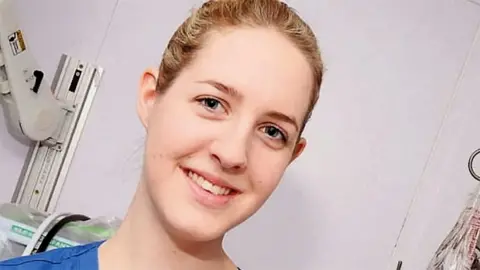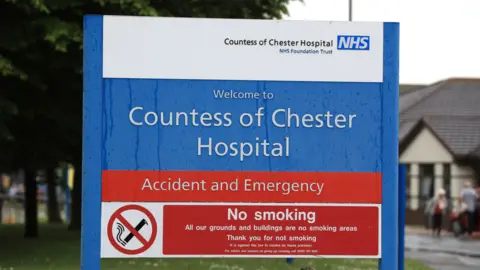Lucy Letby: Baby's blood sugar dangerously low, trial told
 SWNS
SWNSA baby boy's blood-sugar level dropped dangerously low after he received fluids contaminated with insulin, Lucy Letby's trial has heard.
Ms Letby is accused of adding insulin to at least three of the infant's feed bags while on duty at the Countess of Chester Hospital in April 2016.
The nurse is charged with murdering seven babies and attempting to murder 10 others, between 2015 and 2016.
The 33-year-old, originally from Hereford, denies 22 charges.
Giving evidence, medical expert Prof Peter Hindmarsh told Manchester Crown Court that poisoning was the only reasonable explanation for the blood readings of the baby, referred to as Child L, who was on the neonatal unit in early April 2016.
Child L's blood glucose levels remained low throughout 9, 10 and 11 April, even after the intravenous line, and the connected bag containing the nutrients, were replaced.
Subsequent blood examinations found the baby boy's insulin level was at the very top of the scale the equipment was capable of measuring, the court heard.
Prof Hindmarsh, expert in paediatric endocrinology at University College London, agreed the readings could only be explained by "somebody having given insulin to [Child L]."
He noted that, on the basis of Child L's already low blood glucose levels on 8 April, there was no need "whatsoever" for insulin to be given.
He explained to the court that as insulin cannot be given orally, due to its molecular makeup, it would "most likely" have been administered intravenously.
 PA Media
PA MediaGiven the number of hypoglycaemic episodes Child L had over 8 and 9 April, Prof Hindmarsh said the insulin was likely to have been "added to bags used to deliver food".
Asked how much insulin would be needed to cause the low blood sugar levels in Child L, Prof Hindmarsh said: "I have taken quite a conservative view of this, but I would suggest you could add somewhere in the region of 10 units of insulin to a bag, that would be sufficient to produce the hypoglycaemic effect that was measured in the sample.
"Vials of insulin contain 100 units per millilitre, so the volumes we're talking about are quite small and not noticeable on a routine stock check.
"When added to infusion bags you wouldn't notice a change in volume within the bag, nor because insulin is a clear solution."
Boys recovered
Prof Hindmarsh said insulin could be added "fairly easily" through a portal that's located at the bottom of the feed bags.
He told the court that in his opinion, to produce the blood glucose levels detected, around at least three or potentially four bags could have been contaminated.
Ms Letby is accused of trying to kill Child L around the same time she allegedly tried to murder his twin brother, Child M, by injecting air into his bloodstream.
The boys went on to recover and were discharged from hospital the following month.
When interviewed by Cheshire Police following her arrest, Ms Letby denied deliberately administering insulin to Child L, the court was told.
She said that to her knowledge, neither she nor a nursing colleague had accidentally administered the substance.
In his opening address last October to the jury, Ben Myers KC, defending, said there was "nothing in fact" to establish Ms Letby had poisoned Child L and that there was "no obvious cause" to the collapse of Child M.
The trial continues.

Why not follow BBC North West on Facebook, Twitter and Instagram? You can also send story ideas to [email protected]
